Zaragoza Basilica Del Pilar attracts an astonishing 10 million visitors every year. As I walked through its grand halls, I was struck by the intricate blend of Romanesque, Gothic, Mudéjar, and Baroque elements that reflect Spain's rich cultural heritage. The revered image of Our Lady of the Pillar, perched on a jasper column, adds a profound sense of spiritual significance. The basilica's stunning artwork and vibrant festivals are enchanting, but there's something uniquely compelling about its chapels and the heritage of its majestic organ. These ancient walls seem to hold secrets and stories waiting to be uncovered.
History and Significance
When reflecting on the history of the Cathedral-Basilica of Our Lady of the Pillar, it's clear that its origins and transformations tell a story of profound faith and cultural evolution. This basilica, situated in Zaragoza, Spain, holds immense historical significance as the first church dedicated to Mary. The Virgin del Pilar's apparition to Saint James in 40 AD forms the foundation of its sacred narrative. According to tradition, the Virgin instructed Saint James to build a church, which ultimately became the Basilica of Our Lady.
This site has witnessed countless pilgrims, saints, and monarchs paying homage, making it a crucial cornerstone of Christian devotion. Initially, a Romanesque church marked the spot, but over the centuries, it evolved, intertwining with Spain's rich tapestry of faith and culture. The Baroque style that later adorned it adds to its grandeur and historical layers.
The Marian apparition to Saint James not only shaped the basilica's foundation but also instilled a sense of enduring spiritual significance. Each visit to the Cathedral-Basilica of Our Lady of the Pillar connects one to a legacy that spans millennia, celebrating divine encounters and unwavering faith.
Architectural Evolution

Walking through the Cathedral-Basilica of Our Lady of the Pillar, I'm struck by the blend of Romanesque, Gothic, Mudéjar, and Baroque elements that reveal its rich history. The basilica, first built in a Romanesque style, has undergone significant transformations over the centuries, each layer adding to its historical significance.
From the Gothic arches to the intricate Mudéjar brickwork, the basilica showcases a visual conversation between different eras. The current Baroque-style church, completed in 1686, is a masterpiece of ornate decoration. As I wander through the nave, frescoes by Francisco Goya catch my eye, their vibrant colors and dramatic scenes bringing the Virgin's story to life. The layout of the church, a large rectangle with a nave and two aisles, is illuminated by natural light streaming through large oculi.
A quick look at the architectural elements reveals:
| Style | Features |
|---|---|
| Romanesque | Original structure |
| Gothic | Arches and vaults |
| Mudéjar | Brickwork and decorative details |
| Baroque | Ornamentation and Goya's frescoes |
Twelve massive pillars stand as silent sentinels, supporting the vaults and embodying the enduring strength of the Cathedral-Basilica de Pilar. Overlooking the Ebro River, this church is more than a place of worship; it's a testament to Zaragoza's evolving cultural landscape.
Pillar and Image
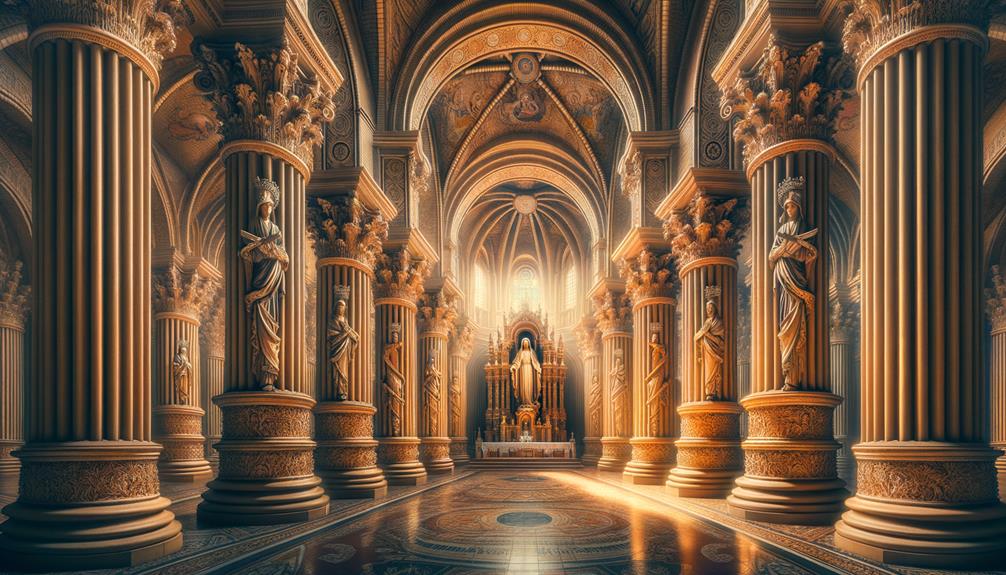
Gazing at the statue of Our Lady of the Pillar, I'm struck by its profound spiritual and historical significance within the basilica. The wooden statue stands majestically on a jasper column, an image revered for centuries. Legend has it that angels fashioned both the image and the pillar during a miraculous journey, infusing them with divine essence.
The main altar, where this sacred pillar and statue reside, is the focal point of the Cathedral-Basilica of Our Lady of the Pillar. The statue was crowned in 1905, a gesture that underscores its importance and adds to its beauty. The crown itself is a masterpiece, symbolizing reverence and devotion.
What truly fascinates me is the apparition of Our Lady of the Pillar to Saint James in 40 AD, a moment symbolically captured by this very statue atop the pillar. This encounter has inspired countless pilgrims and remains a cornerstone of faith within the basilica. Standing before it, I feel a deep connection to the past, a sense of continuity that transcends time and space.
Religious Ceremonies
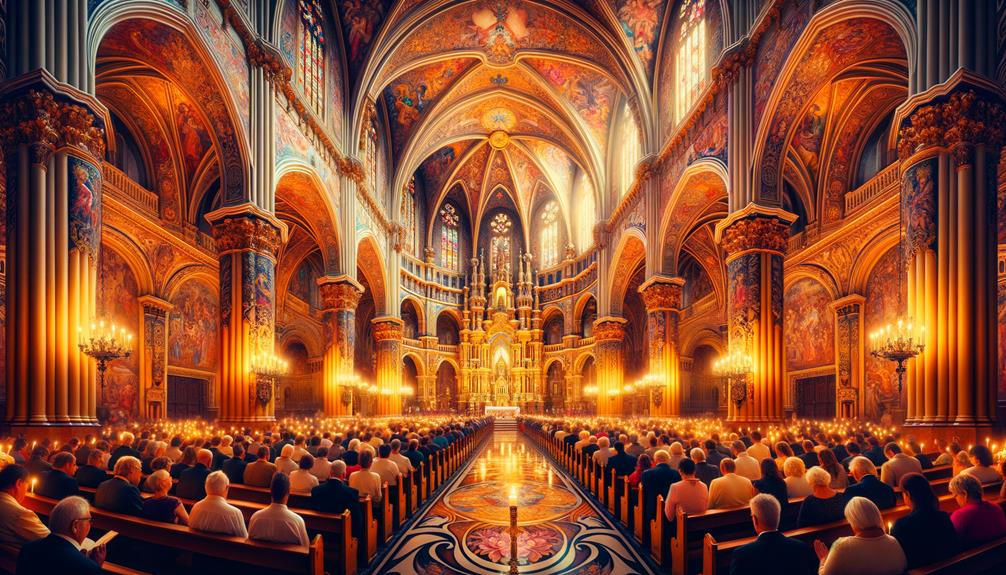
When attending the Basilica del Pilar's religious ceremonies, I'm struck by the deep devotion of the faithful during traditional Marian devotions and festive processional events. The atmosphere is electric, filled with music and prayers that reflect the community's reverence for the Virgin Mary. Witnessing these ceremonies offers a profound glimpse into the cultural and spiritual fabric of Zaragoza, allowing me to better understand the city's rich heritage.
Traditional Marian Devotions
At the Basilica del Pilar, traditional Marian devotions showcase the profound depth of faith and cultural heritage through heartfelt prayers, processions, and offerings to Our Lady of the Pillar. The sacred space resonates with reverence for the Blessed Virgin Mary, where traditional prayers echo through the grand halls. Pilgrims, drawn by their devotion, light candles, leave flowers, and offer colorful ribbons as symbols of their dedication during religious ceremonies.
I've witnessed special masses and blessings that take place regularly, honoring Our Lady of the Pillar and seeking her intercession. The Feast of Our Lady of the Pillar on October 12 stands out as a significant religious ceremony, filled with solemnity and joy. On that day, the basilica attracts believers from around the world, all eager to participate in these rich traditions of Marian devotion.
The symbols of dedication – candles, flowers, and ribbons – reflect the strong connection between the worshippers and the divine. Each offering is a tribute to the enduring influence of Marian devotions at the Basilica del Pilar, where faith and cultural heritage beautifully intertwine. This experience resonates deeply, evoking both reflection and inspiration.
Festive Processional Events
During Zaragoza's annual Fiestas del Pilar, the Basilica del Pilar comes alive with vibrant processional events that showcase the deep cultural and religious devotion of thousands of participants. The streets are filled with festive processions, as people in traditional attire make their way to the basilica. One of the most striking events is the Ofrenda de Flores, where masses of devotees present flowers to Our Lady of the Pillar. Each flower represents faith and reverence, creating a breathtaking display of colors at the basilica's feet.
The Fiestas del Pilar are steeped in communal spirituality, with religious ceremonies celebrating the Virgin Mary's apparition to Saint James the Apostle. The Royal Offering, a deeply revered part of the festivities, sees representatives from the Spanish royal family presenting flowers to the Virgin Mary, underscoring the event's national significance.
These processional events attract not only the devout but also large crowds, filling the city with infectious energy. The Zaragoza Basilica del Pilar stands as a symbol of unity and tradition, where faith and festivity blend beautifully together.
Chapels and Artwork
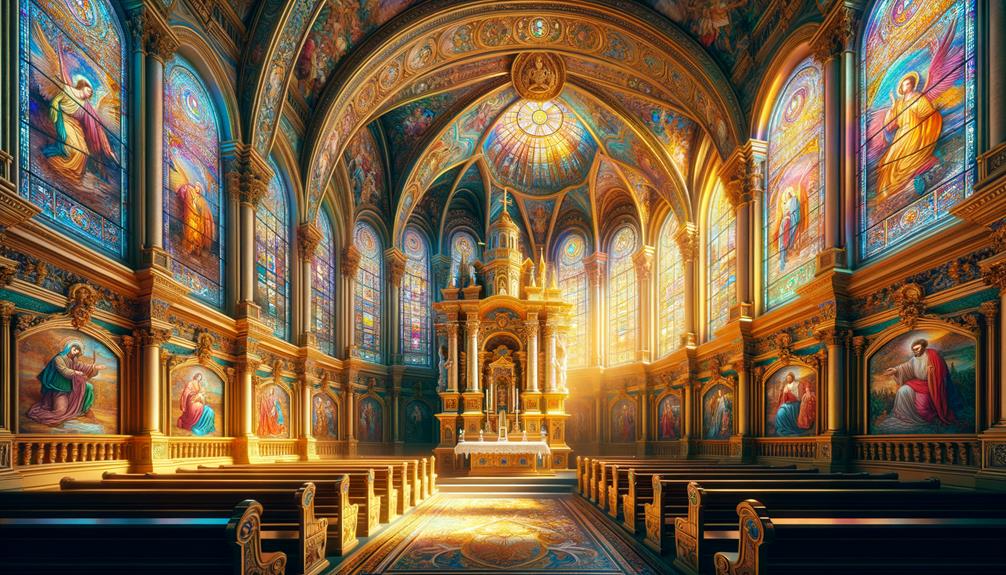
As I explored the Basilica, the chapels caught my attention with their exquisite ornamentation and profound spirituality. The Chapel of Saint Lawrence and Chapel of the Rosary stood out, each offering a unique space for contemplation and devotion. Francisco Goya's masterpieces within these sacred walls added another layer of depth to the experience, blending art and faith in a seamless way.
Notable Chapel Highlights
Stepping into the Cathedral-Basilica of Our Lady of the Pillar is a mesmerizing experience, with intricate chapels and exquisite artwork that narrate a unique chapter of religious and artistic history. The Chapel of the Rosary stands out with its vibrant frescoes, while the Chapel of Joachim draws visitors in with its serene depictions of biblical scenes. The Chapel of Saint Lawrence, with its detailed carvings and statuary, embodies the essence of devotion.
The influence of Francisco Goya is evident, adding depth to these sacred spaces. The intricate ornamentation and religious artwork in each chapel invite contemplation and awe. The Chapel of Saint Pedro de Arbués and the Chapel of Saint Braulio further enrich the basilica's narrative, showcasing different periods of artistic heritage.
As you explore these chapels, you'll uncover the rich religious history and artistic legacy that define the Cathedral-Basilica of Our Lady of the Pillar. The blend of spiritual and aesthetic experiences within these walls creates a profoundly reflective journey, immersing visitors in centuries of faith and creativity.
Goya's Artistic Contributions
Walking through the Basilica, I'm struck by how Francisco Goya's frescoes bring the sacred spaces to life, transforming each chapel into a stunning work of art that blends human devotion with divine inspiration. In the Cathedral-Basilica of Our Lady of the Pillar, Goya's artistic genius shines in the Chapel of the Rosary and other chapels, where his intricate details and religious themes create a profound sense of spirituality.
Goya's mastery of light and shadow in his frescoes is breathtaking, creating a visual experience that draws you in. Each brushstroke seems to capture the essence of the saints, conveying a deep sense of humanity and spirituality. The way he combines colors and contours makes the figures feel almost lifelike, as if they're about to step out of the walls and join the congregation.
Francisco Goya's contributions to the Cathedral-Basilica are historically significant, not only because they add to the basilica's aesthetic beauty but also because they serve as a powerful reminder of the enduring ability of art to inspire faith and freedom. As I stand in these sacred halls, I'm deeply moved by how Goya's legacy continues to resonate, a testament to his unparalleled talent.
Music and Organ Heritage
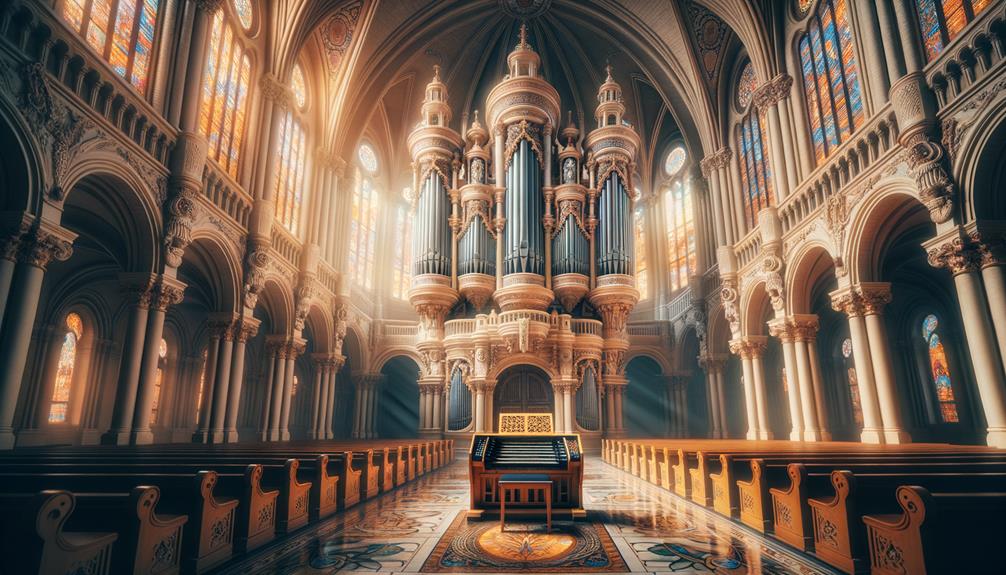
At Zaragoza's Basilica del Pilar, the grand organs by Enrique de Colonia and Martín de Córdoba resonate with history, echoing the cultural richness of centuries past. These majestic instruments, nestled within the Basilica's walls, tell stories of devotion and artistry. The reverberations of the organs, meticulously restructured by Guillermo de Lupe and his son Gaudioso, add a timeless layer to the Basilica's already profound musical heritage.
As I walk through the Chapel of the Rosary and the Chapel of Saint Lawrence, I can almost hear the polyphony that once filled these sacred spaces during the Spanish Golden Age. This was a period when musical activity in the Basilica reached new heights, with intricate harmonies documented as far back as the mid-17th century. The music, rich in texture and depth, speaks of a time when art and faith were deeply intertwined.
Walking through these chapels, I reflect on how the Basilica's musical heritage continues to inspire. Each note played on those historic organs, each chapel echoing with the sounds of centuries-old compositions, reminds me of music's power to transcend time and space.
Cultural Importance

As the historic organ's final notes fade, I'm reminded of the Basilica del Pilar's profound cultural significance, deeply rooted in Spanish identity and heritage. This sacred site, the first church dedicated to Mary, stands as a testament to centuries of devotion and history. Its feast day on October 12 holds double significance, coinciding with Spain's National Day and the anniversary of Columbus's discovery of the New World, underscoring its importance in Spanish culture.
Revered as the Mother of the Hispanic Peoples, the basilica serves as a powerful symbol of Hispanic identity. Pope John Paul II's recognition of its role further solidifies its esteemed status. The statue of Our Lady of the Pillar, adorned in national vestments from various Hispanic colonial nations, visually represents this profound connection. Declared a Bien de Interés Cultural in 1904 and named one of the 12 Treasures of Spain, the basilica's cultural heritage is undeniable. As I walk through its sacred halls, I can sense the enduring spirit of the Hispanic colonial nations and the rich tapestry of Spanish history and identity.
Visitor Information
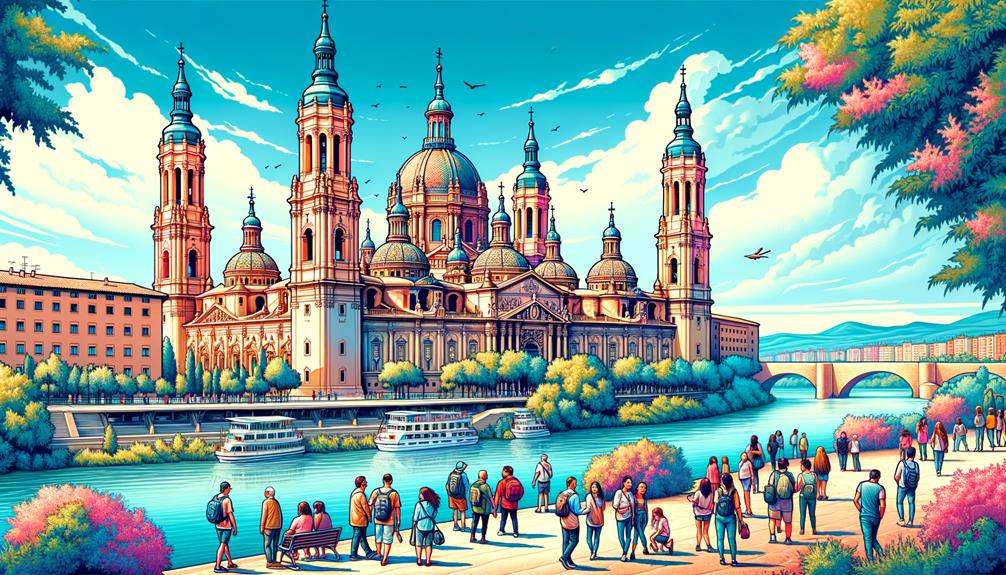
Finding the Cathedral-Basilica of Our Lady of the Pillar in Zaragoza is a breeze, thanks to the convenient connections provided by Zaragoza International Airport and the Plaza del Pilar-Murallas Tram Stop. This historic pilgrimage site has welcomed notable figures like Saint John of the Cross and Saint Teresa of Ávila. When I first visited, I was struck by the unique blend of Romanesque church roots and Baroque style architecture.
For travelers, here's the essential information:
| Category | Details | Notes |
|---|---|---|
| Access | Zaragoza International Airport, Tram Stop | Easy transport connections |
| Accommodations | Booking.com | Wide range of options |
| Notable Visitors | Saint John of the Cross, Saint Teresa of Ávila | Historical and spiritual significance |
Exploring the Zaragoza Basilica Del Pilar is a journey through time, much like visiting other significant shrines like the Shrine of the Virgin of the Rosary of Pompeii in Italy or the Basilica Sanctuary of Our Lady of Nazareth in Brazil. Each visit offers a unique spiritual experience, providing a deep connection to the past. Booking accommodations through Booking.com made my stay seamless, allowing me to focus on the rich cultural insights this magnificent basilica provides.


